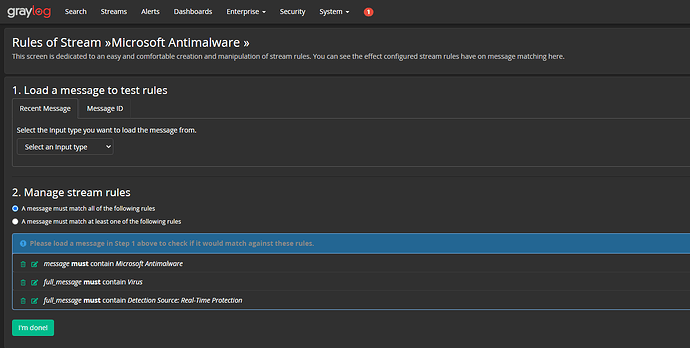I’m grabbing Microsoft Defender for Endpoint events using a powershell script, which outputs all the events for a given duration to a single file. I’m then reading the file into Graylog using filebeat on Windows. The entries are on separate lines with [CR][LF] at the end, so I think I need to use a multiline pattern in the filebeat config, otherwise each line is a separate message.
This works fine, if there’s only 1 event in the log - the problem I’m running into, is that if there’s multiple events in the log, they all go into 1 message. Any ideas on how to tackle this? Maybe using a pipeline would be a better idea? Each event starts with “id” and ends with },
I’m using the following in the filebeat config:
multiline.pattern: '\"id\"'
multiline.negate: true
multiline.match: after
I tried a multiline_flush_pattern, but that just results in nothing making it into graylog
multiline.flush_pattern: '\}\,'
Thanks for any help/advice!
Here’s an edited sample of a log file:
[
{
"id": "12345",
"providerAlertId": "1234567",
"incidentId": "29",
"status": "resolved",
"severity": "medium",
"classification": null,
"determination": null,
"serviceSource": "microsoftDefenderForEndpoint",
"detectionSource": "antivirus",
"detectorId": "abcdefg12345",
"tenantId": "abcdefg12345",
"title": "Bloodhound post-exploitation tool",
"description": "Bloodhound, a post-exploitation open-source reconnaissance tool, has been detected on this device. Bloodhound has been used in a wide range of documented attacks, including attacks involving state-sponsored groups and groups associated with ransomware campaigns. An attacker might be attempting to collect information about users, user sessions, groups, accounts, domain controller properties and permissions. Detections of Bloodhound tools and activity should be thoroughly investigated.",
"recommendedActions": "A. Validate the alert.\n1. Contact the user who ran the tool to verify whether the activity was legitimate and inspect the endpoints for suspicious behavior.\n2. Locate unfamiliar processes in the process tree. Check files for prevalence, their locations, and digital signatures.\n3. Submit relevant files for deep analysis and review file behaviors.\n4. Identify unusual system activities with system owners.\n\nB. Scope the incident. Find related devices, network addresses, and files in the incident graph.\n\nC. Contain and mitigate the breach. Stop suspicious processes, isolate affected devices, decommission compromised accounts, or reset passwords, block IP addresses and URLs, and install security updates.\n\nD. Contact your incident response team, or contact Microsoft support for investigation and remediation services.",
"category": "SuspiciousActivity",
"assignedTo": "Automation",
"alertWebUrl": "https://security.microsoft.com/alerts/blahblahblahblah",
"incidentWebUrl": "https://security.microsoft.com/incidents/blahblahblah",
"actorDisplayName": null,
"threatDisplayName": "HackTool:MSIL/SharpHound!MSR",
"threatFamilyName": "SharpHound",
"mitreTechniques": [
"T1087"
],
"createdDateTime": "2022-12-21T18:40:21.7967173Z",
"lastUpdateDateTime": "2022-12-21T18:52:56.91Z",
"resolvedDateTime": "2022-12-21T18:52:56.7897235Z",
"firstActivityDateTime": "2022-12-21T18:38:49.4766284Z",
"lastActivityDateTime": "2022-12-21T18:48:11.3281966Z",
},
{
"id": "1234567",
"providerAlertId": "1234567",
"incidentId": "29",
"status": "resolved",
"severity": "medium",
"classification": null,
"determination": null,
"serviceSource": "microsoftDefenderForEndpoint",
"detectionSource": "microsoftDefenderForEndpoint",
"detectorId": "1a2b3c4d",
"tenantId": "1a2b3c4d5e",
"title": "\u0027SharpHound\u0027 malware was detected during lateral movement",
"description": "\u0027DefenderObservation.ThreatFamily\u0027 malware was detected on this device. An attacker might be attempting to move laterally to this device from another device on the network.",
"recommendedActions": "A. Validate the alert.\n1. Inspect the file, process, commandline or amsi buffer that was detected.\n2. Check for other suspicious activities in the machine timeline.\n3. Locate unfamiliar processes in the process tree. Check files for prevalence, their locations, and digital signatures.\n4. Submit relevant files for deep analysis and review file behaviors. \n5. Identify unusual system activity with system owners.\n\nB. Scope the incident. Find related machines, network addresses, and files in the incident graph.\n\nC. Contain and mitigate the breach. Stop suspicious processes, isolate affected machines, decommission compromised accounts or reset passwords, block IP addresses and URLs, and install security updates.\n\nD. Contact your incident response team, or contact Microsoft support for investigation and remediation services.",
"category": "LateralMovement",
"assignedTo": "Automation",
"alertWebUrl": "https://security.microsoft.com/alerts/12345_12345",
"incidentWebUrl": "https://security.microsoft.com/incidents/29?tid=1ab3ddddd",
"actorDisplayName": null,
"threatDisplayName": null,
"threatFamilyName": null,
"mitreTechniques": [
"T1021.001",
"T1078"
],
"createdDateTime": "2022-12-21T18:40:49.4268815Z",
"lastUpdateDateTime": "2022-12-21T18:52:56.91Z",
"resolvedDateTime": "2022-12-21T18:52:56.7897235Z",
"firstActivityDateTime": "2022-12-21T18:06:37.0236159Z",
"lastActivityDateTime": "2022-12-21T18:47:23.7266277Z",
},
